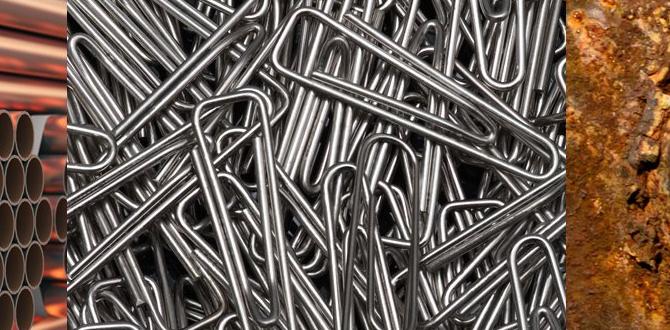Carbide end mill 1/8 inch 1/4 shank stub length for PMMA chip evacuation is crucial for clean cuts and tool longevity when machining acrylics. Proper chip evacuation prevents melting and re-welding, ensuring precise results and protecting your valuable end mill.
When you’re working with materials like PMMA (acrylic), you’ll quickly notice it has a mind of its own. Unlike metals or softer plastics, acrylic can get gummy and melt easily. This is especially true when you’re using a small tool like a 1/8-inch carbide end mill. Melting chips can stick to the cutting edges, leading to poor surface finish, material damage, and even breaking your tool! Don’t worry; it’s a common challenge, and a big part of solving it is understanding and managing something called “chip evacuation.” We’ll walk through exactly what that means and how to get it right, so your PMMA projects turn out perfectly every time.
Understanding PMMA and Chip Evacuation
So, why is chip evacuation such a big deal when machining PMMA with a 1/8-inch carbide end mill? It all comes down to how acrylic behaves under cutting forces. When a cutting tool removes material, it creates chips. In many materials, these chips break away cleanly and are easily cleared from the cutting zone. But with PMMA, the heat generated during cutting can cause the material to soften and even melt.
If these melted chips can’t escape the flutes of your end mill, they can re-weld themselves back onto the workpiece or, worse, pack themselves into the flutes. This packing is affectionately known as “chip bird-nesting.” The consequences are immediate:
- Poor Surface Finish: Melted plastic clinging to your workpiece creates a rough, unsightly surface.
- Material Damage: The heat and re-welding can distort or even ruin your acrylic part.
- Tool Dulling & Breakage: Chips packing into the flutes put immense stress on the cutting edges, dulling them prematurely and increasing the risk of the end mill snapping.
- Increased Cutting Forces: When chips aren’t clearing, the tool has to push through a pile of hot plastic, leading to higher spindle loads and potential chatter.
A 1/8-inch end mill has very small flutes compared to larger tools. This limited space means it’s even more critical for those chips to get out of the way quickly. This is where proper chip evacuation strategies come into play, and it’s often best achieved with specific end mill geometries, optimal cutting parameters, and supporting techniques.
Choosing the Right 1/8-Inch Carbide End Mill for PMMA
When you’re aiming for excellent chip evacuation with PMMA, the geometry of your carbide end mill is paramount. A standard end mill might struggle, but specialized designs make a huge difference. For PMMA, you’ll want to look for these key features:
1. High Helix Angle
A high helix angle on an end mill is designed to help “screw” chips up and out of the cut more effectively. Think of it like a screw conveyor. For PMMA, a helix angle of 30 degrees or more is generally recommended. This aggressive angle increases the rate at which chips are lifted away from the workpiece and out of the flutes.
2. Polished Flutes
Look for end mills with highly polished flutes. These smooth surfaces reduce friction between the chip and the flute wall, allowing chips to slide out more easily. This is like having a non-stick coating for your chips! High-quality manufacturers often use specific processes to achieve this mirror-like finish.
3. Single or Double Flute Design
While multi-flute end mills are great for faster material removal in many materials, for PMMA and excellent chip evacuation with small diameter tools, single or double flute designs are often superior.
- Single Flute: Offers maximum flute space for chip evacuation. This is often the best choice for plastics like PMMA when chip clearing is the primary concern.
- Double Flute: Still provides good flute space and is a good compromise if you need a bit more rigidity or faster feed rates than a single flute allows.
Avoid end mills with four or more flutes for PMMA machining, as the limited space in the flutes will quickly become packed with melting chips.
4. “Stub” or “Short” Length
For PMMA, a stub length end mill (where the cutting length is shorter than the overall shank length) can sometimes improve rigidity. While not directly related to chip evacuation, a more rigid tool vibrates less, which can contribute to cleaner cuts and indirectly help with chip flow by preventing chatter. However, the flute design and polishing are far more critical for chip evacuation itself.
5. Material: Solid Carbide
Solid carbide is essential for its hardness and ability to withstand the heat generated when cutting acrylic. While coatings can sometimes help, for PMMA, the inherent properties of polished carbide with a suitable geometry are usually sufficient.
Here’s a quick comparison of flute designs for PMMA:
| Flute Count | Pros for PMMA Chip Evacuation | Cons for PMMA Chip Evacuation |
|---|---|---|
| Single Flute | Maximum flute volume for excellent chip clearance. | Can be less rigid than multi-flute tools. |
| Double Flute | Good flute volume, better rigidity than single flute. | Less flute volume than single flute. |
| Triple/Quad Flute | Higher metal removal rates in some materials, more rigid. | Severely restricted flute volume, high risk of chip packing and melting in PMMA. |
When searching for these tools, look for descriptions like “plastic cutting end mill,” “acrylic end mill,” or “fast spiral end mill” with a high flute polish. A “1/8 inch 1/4 shank stub length carbide end mill for plastics” is a good search to start with.
Optimizing Cutting Parameters for PMMA
Even with the perfect end mill, poor cutting parameters will lead to melting and chip packing. It’s a delicate balance between removing material efficiently and not generating excessive heat. Here are the key parameters to focus on:
1. Spindle Speed (RPM)
For PMMA, you generally want to run your spindle at a relatively high RPM. This allows the cutting edges to pass through the material quickly, generating heat but also clearing chips before they have a chance to melt and stick.
- General Guideline: Start in the range of 15,000 – 25,000 RPM. However, this is highly dependent on the specific end mill, machine rigidity, and coolant/air blast, so experimentation is key.
Higher spindle speeds with appropriate feed rates help create a shearing action that produces smaller, manageable chips.
2. Feed Rate
This is arguably the most critical parameter to get right for PMMA. The feed rate is how fast the end mill advances into the material. If you feed too slowly, the cutting edges dwell in the material, generating excessive heat and melting. If you feed too fast, you can overload the tool and break it.
- Key Principle: Aim for a feed rate that produces a small, consistent chip. You want to hear a “faint whistling” or “light scraping” sound, not a loud, grating noise.
- Starting Point: For a 1/8-inch end mill, a good starting point might be between 15-30 inches per minute (IPM) or 380-760 mm/minute. Adjust based on chip formation and surface finish.
The feed rate is directly related to the spindle speed and chip load (the amount of material removed per tooth). A common formula is: Chip Load = (Feed Rate) / (Spindle Speed Number of Flutes). You’re aiming for a chip load that’s appropriate for the material and tool.
3. Depth of Cut (DOC) and Width of Cut (WOC)
For PMMA, it’s often best to take relatively light depths of cut and widths of cut. This reduces the amount of material the end mill has to remove at any given moment, which also reduces heat generation and stress on the tool.
- Depth of Cut (DOC): For a 1/8-inch end mill, a DOC of 0.040″ to 0.080″ (1mm to 2mm) is a good starting range. For roughing, you might go slightly deeper, but for finishing passes, keep it very shallow.
- Width of Cut (WOC): When profiling or slotting, try to avoid taking a full-width cut if possible. Take multiple passes or use a step-over strategy if you’re pocketing. A Width of Cut of 0.040″ to 0.100″ (1mm to 2.5mm) might be a good starting point for profiling.
Using a smaller WOC in pocketing operations is sometimes called “high-efficiency machining” and involves taking many lighter passes to clear material, which also helps with chip evacuation.
4. Air Blast or Coolant
While many machinists avoid liquid coolants with acrylic because they can cause crazing (tiny cracks), a sharp blast of compressed air is invaluable.
- Air Blast: Directing a strong stream of compressed air at the cutting zone is crucial. It cools the cutting edge and physically blows chips away from the workpiece and out of the flutes. Many CNC machines have a designated air blast output for this purpose. For manual or hobby machines, a separate air nozzle or even a repurposed blower can make a significant difference.
- Mist Coolant: A light mist of a syntheti, or specialized plastic-friendly coolant can* be used, but be extremely cautious. Too much fluid, or the wrong type, can cause crazing of the PMMA. Always test on scrap material first.
Good chip evacuation is a dynamic process, and a constant supply of air helps keep things from getting gummy.
Step-by-Step Machining Process for PMMA
Now, let’s put it all together into a practical, step-by-step guide for machining PMMA with your 1/8-inch carbide end mill.
Step 1: Secure Your PMMA Workpiece
- Clamping is Key: Ensure your PMMA sheet or block is held down firmly and securely. Use clamps that distribute pressure evenly to avoid cracking the material. Avoid overtightening.
- Support: For larger sheets, use a sub-plate or backer board (like MDF) underneath. This helps prevent vibration and blowout on the bottom surface.
Step 2: Select and Inspect Your End Mill
- Use the Right Tool: As discussed, choose a high-helix, polished flute, single or double-flute carbide end mill designed for plastics.
- Check for Damage: Ensure your 1/8-inch end mill is sharp, clean, and free from any nicks or signs of wear. A dull tool will generate more heat and lead to melting.
Step 3: Set Your Cutting Parameters
- Program or Set: Input your RPM, feed rate, depth of cut, and width of cut into your CNC controller or set them manually on your milling machine.
- Start Conservatively: It’s always better to start with lighter cuts and slightly slower feed rates than recommended and increase them gradually while observing chip formation and listening to the cut.
- Example Parameters (for a typical 1/8″ 2-flute plastic end mill):
- Spindle Speed: 18,000 – 22,000 RPM
- Feed Rate: 20 – 25 IPM (500 – 635 mm/min)
- Depth of Cut: 0.050″ (1.25 mm)
- Width of Cut (Profiling/Slotting): 0.060″ (1.5 mm)
- Width of Cut (Pocketing Step-over): 0.040″ (1.0 mm)
Step 4: Set Up Air Blast
- Position the Nozzle: Aim a compressed air nozzle directly at the point where the end mill enters the material. The air should flow in the direction of cutting and help push chips away.
- Constant Flow: Ensure the air blast is active before you start cutting and remains on throughout the operation.
Step 5: Perform a Test Cut
- Scrap Material: Always perform a test cut on a scrap piece of PMMA that is the same thickness and type as your main workpiece.
- Observe and Listen: Watch the chips being produced. Are they small and stringy, or are they melting into a gummy mess? Listen to the sound of the cut. A smooth, consistent sound is good.
- Adjust as Needed: If you see melting, try increasing the feed rate slightly, or reducing the depth of cut. If the cut sounds rough or the tool vibrates, you might need to adjust RPM or feed rate.
Step 6: Execute the Machining Operation
- Gentle Entry: For manual machines, ease into the cut smoothly. For CNC, trust your programmed speeds and feeds.
- Monitor Continuously: Keep an eye (and ear) on the operation. Be ready to stop the machine immediately if you see signs of melting, excessive vibration, or hear unusual noises.
- Clearance Passes: If you’re performing multiple passes for depth, ensure chips are cleared from the flutes between passes. You might even do a “dry run” pass with just air blast to clear out any residual chips.
Step 7: Post-Machining Inspection
- Check for Melting: Once the operation is complete, carefully inspect the edges and surfaces of your PMMA part. Look for any signs of melted plastic.
- Clean the Tool: Gently clean the end mill with a brush and solvent (like isopropyl alcohol) if necessary to remove any residual plastic. This prepares it for the next job and maintains its sharp edge.
Troubleshooting Common PMMA Machining Issues
Even with careful setup, you might encounter problems. Here’s how to solve them:
Problem: Melting and Chip Packing in Flutes
- Cause: Heat buildup is too high, chips are not being evacuated quickly enough.
- Solutions:
- Increase feed rate.
- Decrease depth of cut.
- Improve air blast effectiveness (stronger air, better nozzle angle).
- Try a higher spindle speed.
- Ensure flutes are perfectly clean and polished.
- Consider a single-flute end mill if using a double-flute.
Problem: Poor Surface Finish (Rough or Fuzzy Edges)
- Cause: Dull tool, incorrect cutting parameters, chatter, or micro-melting.
- Solutions:
- Ensure end mill is sharp and clean.
- Adjust feed rate and spindle speed for a better chip load.
- Reduce depth of cut.
- Check for workpiece rigidity and machine stability to prevent chatter.
- Ensure effective chip evacuation so chips aren’t re-cutting.
Problem: Tool Breakage
- Cause: Excessive cutting forces, chatter, chip packing, or a flawed tool.
- Solutions:
- Significantly reduce depth of cut and/or width of cut.
- Increase feed rate to avoid dwelling and heat buildup.
- Ensure spindle speed is appropriate.
- Check for and eliminate chatter.
- Verify that chip evacuation is functioning perfectly.
- Use a more rigid tooling setup if possible (though a 1/8″ end mill is inherently limited).
Problem: Crazing (Tiny Surface Cracks)
- Cause: Chemical attack from coolants, excessive stress, or heat shock.
- Solutions:
- Avoid using liquid coolants unless specifically designed for plastics and tested on scrap.
- Ensure cutting parameters are not too aggressive, minimizing heat and stress.
- Allow the PMMA to acclimate to room temperature before and after machining.
- Handle the part gently to avoid introducing stress.
The Importance of a Rigidity Setup
While we’ve focused heavily on chip evacuation, it’s built upon a foundation of rigidity. A wobbly machine or tool holder will fight against good chip evacuation by introducing chatter, which exacerbates melting and poor finish.
Machine Tool Condition
Ensure your milling machine itself is in good repair. Worn ways, loose gibs, or a shaky spindle can all lead to poor cutting performance. For hobbyists, a small desktop CNC or a sturdy benchtop mill is essential. Investing in a quality collet system (like ER collets) that provides excellent concentricity for your 1/8-inch end mill is also crucial. A “runout” of even a few thousandths of an inch can make a big difference when working with small, delicate tools and materials prone to melting.
Workholding Rigidity
As mentioned, clamp your workpiece securely. If it can move, vibrate, or lift during the cut, your machining will suffer. Consider using a vacuum table for larger, flatter parts if your machine supports






